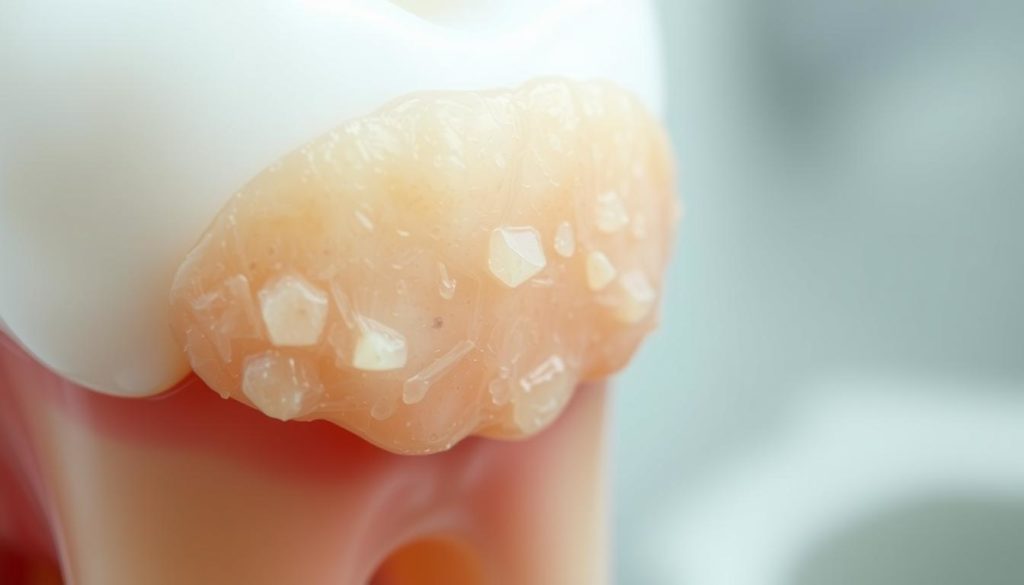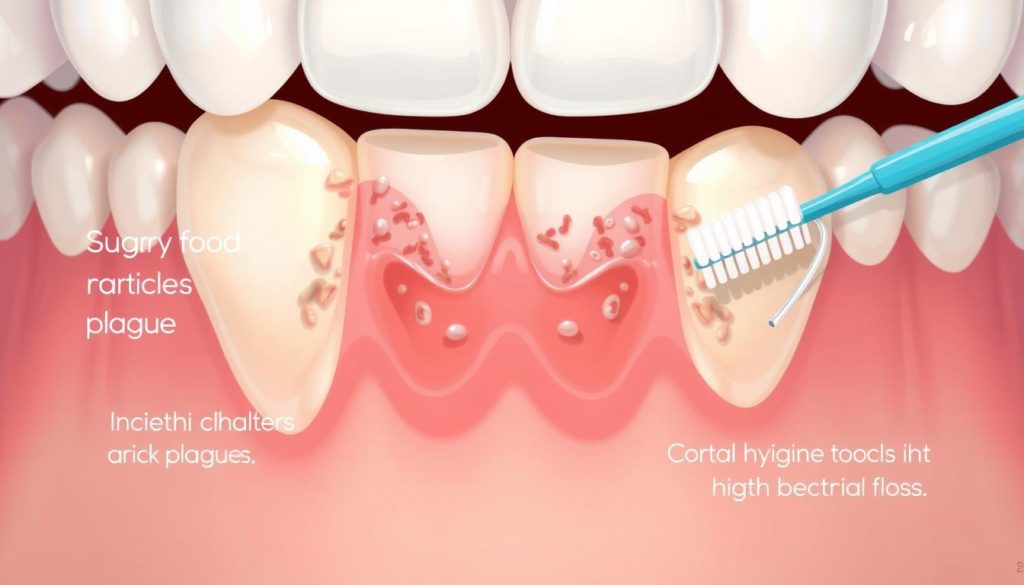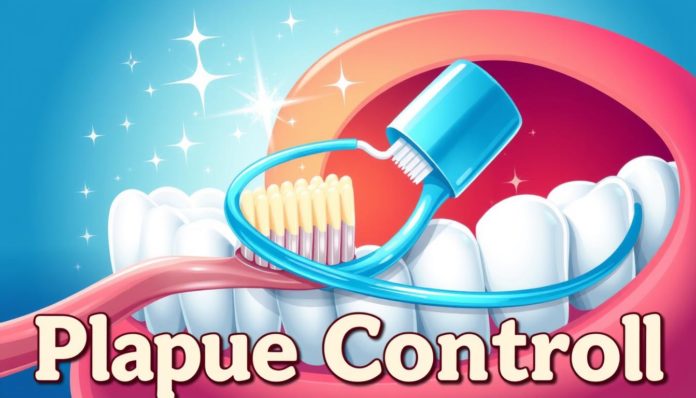Did you know that 68% of adults have tartar on their teeth? Dental plaque is more than just a cosmetic issue. It can seriously harm your oral health. This guide will explain what plaque is, why it forms, and how to stop it.
Dentists warn that ignoring plaque can lead to gum disease and tooth decay. But there’s hope! With simple dental care tips and strategies, you can keep your smile healthy. Let’s start your journey to a plaque-free mouth!
What is Dental Plaque?

Dental plaque is a common term in oral hygiene. But, understanding what it truly entails can help in better managing it.
Definition of Dental Plaque
Dental plaque is a biofilm or mass of bacteria that grows on surfaces in the mouth. It’s a sticky, colorless deposit. It forms when bacteria in the mouth interact with food particles and saliva.
How Plaque Forms
The plaque formation process starts with eating carbohydrates. These provide a food source for bacteria. The bacteria then produce acids that mix with leftover food particles, creating a film.
This biofilm, or plaque, sticks to the teeth, especially along the gum line.
Common Symptoms of Plaque Buildup
It’s important to recognize the symptoms of plaque on teeth for good oral health. Common signs include bad breath, a visible yellowish or white coating on the teeth, and inflammation or bleeding of the gums.
If left untreated, plaque can harden into tartar. This makes oral hygiene efforts even harder.
| Stage | Description | Symptoms |
|---|---|---|
| Initial | Plaque formation begins on teeth | Bad breath, mild gum irritation |
| Intermediate | Plaque thickens and become more visible | Yellowish coating, moderate gum inflammation |
| Advanced | Plaque hardens into tartar | Severe gum swelling, bleeding, bad breath |
Causes of Plaque Formation
Understanding the causes of plaque formation is key to fighting dental problems. Diet and oral hygiene habits are major contributors to this issue.
Diet and Plaque Formation
A diet rich in sugary and starchy foods is a big culprit. These foods mix with mouth bacteria, creating acids that harm teeth. This leads to diet-related plaque and speeds up plaque growth on teeth.
“A study by the American Dental Association found that people who consume high amounts of sugar and carbohydrates are more likely to develop plaque and experience dental problems.”

Poor Oral Hygiene
Oral hygiene is vital in stopping plaque buildup. Not brushing and flossing regularly lets plaque turn into tartar. Only a dentist can remove tartar. Keeping up with oral care is crucial to prevent plaque’s harmful effects.
The Role of Bacteria in Plaque Formation
Knowing about plaque bacteria is key to good oral health. Plaque is a sticky film of bacteria that forms on teeth and gums. It’s part of the oral microbiome, a community of many bacterial species.
The bacterial biofilm is crucial in plaque formation. It’s a community of bacteria that sticks to teeth and is hard to remove. Inside this biofilm, bacteria grow, making acids and more plaque.
Plaque bacteria have different roles. Bacteria like Streptococcus mutans start the process. They eat sugars and make acids that harm teeth and cause cavities.
The oral microbiome is complex. Some bacteria help, while others harm. Keeping this balance is important. Brushing and flossing can help by breaking up the bacterial biofilm.
To understand better, here’s a breakdown:
| Bacterial Species | Function in Plaque Formation |
|---|---|
| Streptococcus mutans | Initial colonizer; produces acid that leads to enamel decay |
| Porphyromonas gingivalis | Secondary colonizer; associated with gum disease |
| Actinomyces | Contributes to root surface plaque |
| Veillonella | Often found in more mature plaque; helps breakdown lactic acid |
Health Risks Associated with Plaque Buildup
Dental plaque buildup can cause serious health problems if not treated. It’s important to keep your teeth clean and visit the dentist regularly. This helps prevent many issues.
Gum Disease
Gum disease is a big risk from plaque buildup. It starts with gingivitis, which makes your gums swell and bleed. If not treated, it can turn into periodontitis.
Periodontitis is worse and can lead to losing teeth and damaging the jawbone. It’s a serious problem that needs attention.
Tooth Decay
Tooth decay is another big worry. Plaque has bacteria that make acid, which can damage your teeth. Without care, cavities can get bigger and cause pain and infection.
Other Health Complications
Plaque bacteria can affect more than just your teeth. They might be linked to heart disease, diabetes, and breathing problems. So, fighting plaque is key for your health, not just your teeth.
How to Identify Plaque on Teeth
It’s important to spot dental plaque early to keep your mouth healthy. Plaque is a sticky, colorless film of bacteria that builds up on your teeth and gums. Knowing how to see it and getting a dentist’s opinion are key steps in fighting this common dental problem.
Visual Indicators
At home, you can spot plaque by looking for certain signs. A sticky, pale film on your teeth is a big clue. You can feel this film with your tongue, especially near your gums.
When plaque hardens, it turns yellow or brown. You’ll see it most between your teeth and along your gum line.
Professional Diagnosis
Even if you see plaque at home, it’s smart to get a professional dental diagnosis. Your dentist will use special tools to find and measure plaque. Regular cleanings catch plaque early and remove it well, avoiding bigger problems later.
| Identification Method | Description |
|---|---|
| Visual Inspection | Looking for a sticky, colorless film, or yellowish deposits on teeth. |
| Professional Diagnosis | Utilizing dental tools and expertise for accurate detection and removal. |
Effective Plaque Removal Techniques
Keeping your mouth clean is key. You need to know how to remove plaque. This includes brushing right, flossing well, and using the right dental products.
Brushing Techniques
Brushing is crucial in fighting plaque. Here’s how to brush effectively:
- Use a toothbrush with soft bristles.
- Hold the toothbrush at a 45-degree angle to your gums.
- Brush in gentle, circular motions.
- Make sure to brush all tooth surfaces, including the outer, inner, and chewing sides.
- Brush for at least two minutes.
Flossing Methods
Flossing gets into tight spots that your toothbrush can’t. It removes plaque from between teeth and under the gumline. Here’s how to floss right:
- Start with 18 inches of floss, wrapping most around your middle fingers.
- Hold the floss tightly between your thumbs and forefingers.
- Slide the floss between your teeth gently, moving it back and forth.
- Curve the floss into a C shape against one tooth and slide it under the gumline.
- Do this for each tooth, using a new section of floss each time.
Mouthwash and Dental Products
Using mouthwash and dental products can also help. They add to your oral care routine:
| Product | Purpose | Brands |
|---|---|---|
| Mouthwash | Reduces bacteria and freshens breath | Listerine, Crest Pro-Health |
| Electric Toothbrush | Provides a more thorough clean | Sonicare, Oral-B |
| Floss Picks | Convenient for quick flossing | Plackers, DenTek |
Using these techniques together ensures your teeth and gums stay healthy.
Best Practices for Plaque Prevention
Keeping your mouth healthy means following some key steps. To fight plaque, you need to get regular dental cleanings, brush right, and eat wisely.
Routine Dental Cleanings
Getting your teeth cleaned regularly is key. Experts say you should go to the dentist every six months. This helps remove plaque and tartar that brushing and flossing can’t get rid of.
Dental cleanings also help catch problems early. This ensures your whole mouth stays healthy.
Proper Brushing Habits
Brushing correctly is crucial for fighting plaque. Choose a good toothbrush and toothpaste with fluoride. Brush for two minutes, twice a day, and make sure to clean all parts of your mouth.
Healthy Diet Choices
Eating right is also important for your mouth. Try to eat less sugar and more foods with vitamins and minerals. Crunchy fruits and veggies can clean your teeth, and dairy helps keep your enamel strong.
The Importance of Consistent Plaque Control
Plaque control is vital for good dental health. Plaque, a sticky film of bacteria, can harm your teeth if not managed. It’s important to keep it under control.
To control plaque, a regular oral hygiene routine is essential. Brushing at least twice a day and flossing daily helps a lot. Using mouthwash also reduces plaque buildup.
Regular dental visits are also crucial. They help remove plaque and tartar that brushing and flossing can miss. This shows how important plaque control is for your teeth.
Here’s a simple oral hygiene checklist:
- Brush twice daily with fluoride toothpaste.
- Floss once a day to remove food particles between teeth.
- Use an antiseptic mouthwash to kill bacteria.
- Regular dental check-ups and professional cleanings.
Keeping plaque in check is not just for a nice smile. It’s key for long-term dental health.
Choosing the Right Dental Products for Plaque Prevention
Choosing the right dental products is key to fighting plaque. This part will explore dental products for plaque prevention. We’ll look at anti-plaque toothpaste and interdental cleaning tools. Knowing how they work can help keep your mouth clean.
Toothpaste Options
Anti-plaque toothpaste is essential for avoiding plaque. Look for toothpaste with fluoride and antimicrobial agents. These help remove food and bacteria. Brands like Colgate Total and Crest Pro-Health are great for fighting plaque.
Floss and Interdental Cleaners
Flossing is vital, but don’t overlook interdental cleaners. Tools like Waterpik Water Flossers and interdental brushes clean areas floss can’t. They’re important for a thorough interdental cleaning routine.
Mouthwash Benefits
A good mouthwash can boost your oral care. Antimicrobial mouthwashes, like Listerine and Crest, kill bacteria and reduce plaque. Use mouthwash along with brushing and flossing for the best dental products for plaque prevention.
FAQs About Plaque and Dental Hygiene
Do you have questions about plaque and dental hygiene? Let’s explore some common questions to improve your oral health knowledge.
Dental plaque is a sticky, colorless film of bacteria that forms on your teeth. If not removed, it can turn into tartar and cause oral health issues.
How can I prevent plaque buildup?
Keeping up with a regular oral hygiene routine is key. Brush your teeth twice a day, floss every day, and use antibacterial mouthwash. Don’t forget to get routine dental cleanings.
Does my diet affect plaque formation?
Yes, eating sugary and starchy foods can lead to plaque buildup. Eat a balanced diet with fruits, vegetables, and water to help your teeth.
Are there specific toothpaste and mouthwash recommendations to fight plaque?
Yes, choose toothpaste and mouthwash with fluoride and antibacterial agents. Look for ADA-approved products from brands like Colgate or Crest.
Can I see plaque on my teeth?
Plaque is usually colorless or pale yellow, making it hard to spot. Dental professionals use special dyes to highlight it during checkups.
What are some effective home remedies to combat plaque?
Good brushing and flossing habits are key. Some people also use baking soda, oil pulling, or coconut oil. But remember, these should not replace standard dental care.
For more plaque FAQs and answers to common dental hygiene questions, always talk to your dentist. Regular visits will help keep your mouth healthy.
Plaque: Understanding its Impact on Your Oral Health
Plaque is a sticky film of bacteria that forms on your teeth. If left alone, it can cause many oral health problems. These include cavities and serious gum infections.
Tooth decay is a direct result of plaque. The bacteria in plaque make acids that damage tooth enamel. This can lead to pain, sensitivity, and even more serious dental issues. Keeping your teeth clean through brushing and flossing is key to avoiding these problems.
Plaque also affects your gums. It can cause gum inflammation, or gingivitis, which can turn into periodontitis if not treated. This severe gum disease can lead to tooth loss and is linked to heart disease and diabetes. So, it’s important to brush, floss, and visit the dentist regularly to fight plaque’s effects on your oral health.
FAQ
What is dental plaque?
Dental plaque is a sticky, colorless film of bacteria that forms on our teeth. It’s like a biofilm that can hold harmful bacteria. These bacteria can cause tooth decay and gum disease.
How does dental plaque form?
Plaque forms when food particles mix with saliva and bacteria in the mouth. Bacteria feed on sugars and starches, producing acids. These acids can harm teeth if not removed.
What are common symptoms of plaque buildup?
Signs of plaque buildup include bad breath, a yellowish or white coating on teeth, and inflamed gums. If ignored, it can lead to cavities and gingivitis.
How can diet contribute to plaque formation?
Eating sugary and starchy foods gives bacteria the fuel to produce acids. These acids can erode tooth enamel and help plaque form.
What role does poor oral hygiene play in plaque buildup?
Not brushing and flossing regularly lets plaque build up and harden into tartar. Good oral hygiene is key to preventing plaque.
What bacteria are involved in plaque formation?
Bacteria like Streptococcus mutans and Lactobacillus play a big role in plaque formation. They thrive on tooth surfaces and produce acids that harm teeth.
What are the health risks associated with plaque buildup?
Plaque buildup can cause gum disease, tooth decay, and even heart disease and diabetes. Bacteria can enter the bloodstream and cause systemic conditions.
How can you identify plaque on your teeth?
Look for a sticky, pale film on your teeth to spot plaque. Regular dental check-ups are also important for monitoring plaque levels.
What are effective techniques for plaque removal?
Effective methods include brushing twice a day for two minutes, flossing daily, and using mouthwash. Dental products designed for plaque control are also helpful.
What are the best practices for plaque prevention?
To prevent plaque, maintain regular dental cleanings, brush properly, floss daily, and choose a healthy diet. Avoid sugary and starchy foods.
Why is consistent plaque control important?
Keeping plaque under control is vital for oral health. Regular hygiene practices prevent plaque buildup and reduce the risk of cavities and gum disease.
How do you choose the right dental products for plaque prevention?
For plaque prevention, choose toothpaste with fluoride, interdental cleaners like floss or picks, and mouthwash that targets plaque bacteria. These products enhance your oral hygiene routine.


